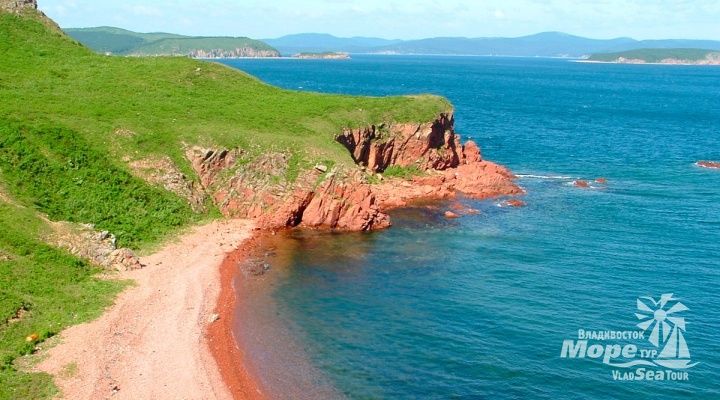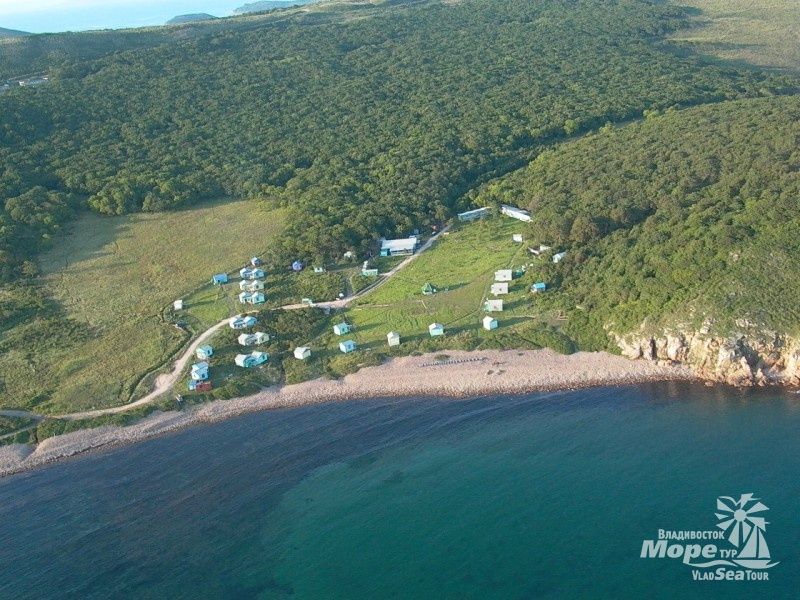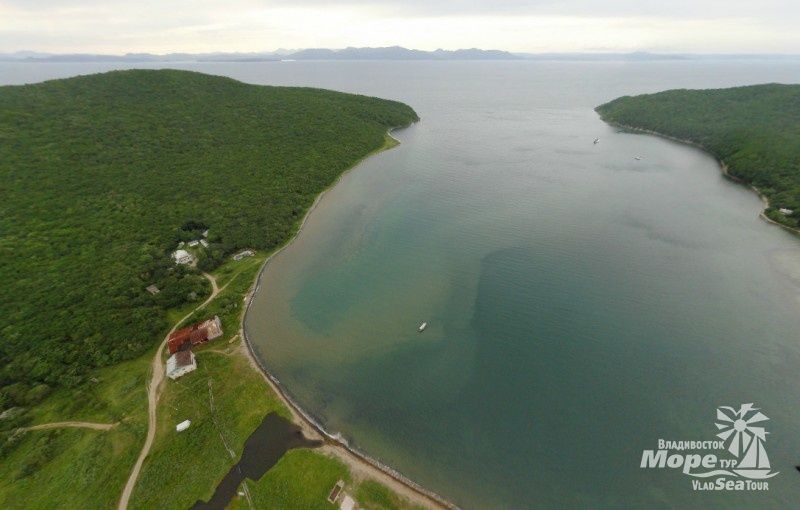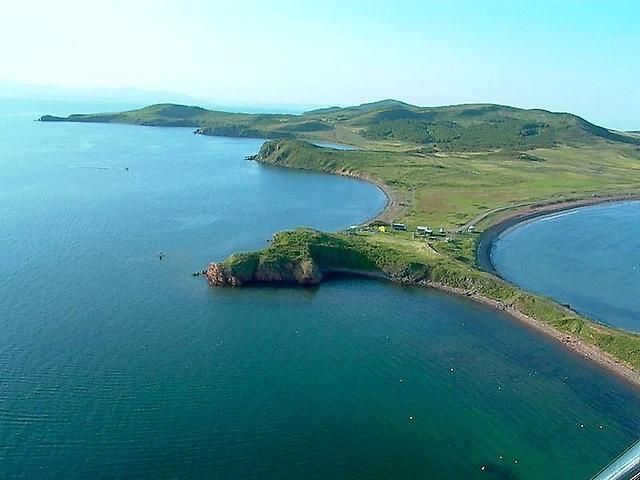Untitled
Popov Island is one of the most popular recreation spots in Primorsky Krai not only for residents of Primorsky Krai itself but also for the entire Far East. The island will give its guests an unforgettable vacation. Primorsky Krai is rich in natural attractions. It is named after the Russian Admiral Popov A.A. and is part of the Admiralty Islands ridge, located in Peter the Great Bay, which is the largest and most beautiful bay in the Sea of Japan. By its location, Popov Island divides Peter the Great Bay into Ussuri Bay and Amur Bay. The island's location makes it stand out due to constant washing by clean seawater flowing from the Sea of Japan.
The island is administratively part of Vladivostok and is located 20 km south of its center. Communication between the city and the island is maintained through a year-round ferry crossing and a passenger ship.
Recreation on Popov Island is quite diverse. It includes relaxation on the picturesque sandy beaches of Primorye and its shores, fishing and diving, visiting the island's attractions and historical values. The island's nature will help you forget about your problems and the hustle and bustle of the city. Here you can have an interesting time and return home with a lot of impressions.
Pogranichnaya Bay, called "French Beach" by islanders, will warmly welcome you with soft white sand, blue sky, warm clear sea, and wonderful landscapes with many islands of Peter the Great Bay. In kiosks and shops operating on the beach territory in Pogranichnaya Bay, you can always buy cool drinks, light alcohol, juices, and seafood. September is the time of low tides, so it warms up well. The best time to relax on Popov Island is from July to September, as the velvet season has the most sunny days, as well as the highest sea water temperature (up to +25°C). Fishing enthusiasts will find the period from June to July suitable, while spearfishing is best done from July to September. The swimming season usually closes around October 5-15.
Geography
Popov Island is geographically located southwest of Russky Island. Russky and Popov Islands are separated by the Stark Strait, which is 200 meters wide and about 4-5 meters deep. To the south of the island is Reyneke Island. The highest point of the island is Popov Mountain, with a height of 158 meters. The island's landscape is quite diverse: from coastal cliffs to flooded meadows, hills, and uplands, and the coastline itself is quite rugged.
To the east of Popov Island are the small uninhabited islands of Klykov, Naumov, and Maly.
History
Popov Island itself received its first name, Rynda Island, in 1860 in honor of the corvette "Rynda". The indigenous name of the island is Mama-sakha, meaning "Black Shore under a Lonely Star". It was surveyed in 1862-63 by an expedition led by Lieutenant Colonel V. M. Babkin, which meticulously mapped the coast of Peter the Great Bay. During this expedition, Reyneke and Rikord Islands were studied and named. Rynda was renamed Popov Island in honor of the commander-in-chief of the Pacific Squadron, A. A. Popov.
On the coast of Popov Island, you can see fortifications that were built in 1932-1933 after the invasion of Japanese troops into Manchuria. One of the key positions of the defensive structures covering the sea approaches to Vladivostok was coastal battery No. 901, which consisted of a command-rangefinder post located on the top of Popov Mountain (the highest point of the island, 158 m), and a firing position located in a deep hollow.
The first settlements on Popov Island date back approximately 3-4 thousand years ago; traces of their presence were found in the bay of the Stark Strait. Scientists still find many fragments of ancient pottery in shell middens. Archaeological excavation materials show that marine organisms were the main food source for ancient people, and they became objects of cult worship.
The first crab cannery appeared on Popov Island after the end of the Civil War. The number of workers was about 200 people. Along with Russians, Korean and Chinese fishermen often worked there. Work at the factory was seasonal – workers were brought in during spring (March-May) and autumn (October-November) for the fishing season. There was no permanent population on the island. About 300 thousand crabs were caught per season.
In 1926, the Russian Geographical Society opened a zoological nursery on the island. The purpose of the nursery was to breed minks, arctic foxes, silver-black foxes, and spotted deer. There were also plans to open a zoo in Vladivostok.
In 1927, industrial fishing and coastal fish processing began on Popov Island. The "Ostrovnoy" fur farm and the Fish Factory were the main enterprises of the island in the 1970s-1980s. Also in the 1970s, the island housed scientific divisions of the Pacific Research Institute of Fisheries and Oceanography (TINRO), the Marine Reserve (DGMS), and the Institute of Oceanology of the Far Eastern Branch of the Russian Academy of Sciences. Currently, the island hosts a station of the Institute of Oceanology of the Far Eastern Branch of the Russian Academy of Sciences and the Museum of Nature of the Marine Reserve.
"Legend of the Pirates"
A legend has it that on Popov Island, in Alekseeva Bay, there was a base of Chinese pirates, and on the steep cape stood a pirate lookout tower. To this day, Cape Prokhodnoy, dissected by deep crevices, is called the Dragon King's Palace (Dragon's Lair). Here, it is believed, pirates executed captives and threw their bodies as sacrifices to sea dragons.
In the 1880s, "Alekseev" pirates intercepted a state vessel carrying provisions and money for defensive works at the Vladivostok fortress. At night, a detachment of Russian sailors secretly set off for the island in rowing boats. Through a pass, the sailors reached Alekseeva Bay. The pirates were caught without a fight, as they were drunk, having consumed several barrels of vodka from the captured ship. The pirates' arsenal included not only swords, tridents, but also multi-barreled mitrailleuses installed on the decks of three fast junks. A large number of British and American rifles and revolvers were also seized.
However, the money (about 80 thousand silver rubles) was never found. The merchant Menard, who later bought the island, repeatedly attempted to find the money, rumored to be hidden by the pirates. But he was unsuccessful: Chinese pirates were masters at hiding treasures. In the top of a kekur or coastal rock, they would use hand drills to make a narrow, long bore hole, calculated so that its entrance was a few tens of centimeters from the cliff face. Then they would lower the treasure into it and fill it with concrete mixed with the excavated rock. From the outside, such a treasure was invisible and could only be extracted by those who knew exactly where it was. This fact haunts adventurers and treasure hunters from all over the Far East. Anyone can go there in search of treasure.
Nature
Popov Island, like many other islands in Peter the Great Bay, was once connected to the mainland, and therefore, the composition of its plant life is similar to that of the Muravyov-Amursky Peninsula. About ten thousand years ago, there was a transgression, a rise in sea level, and the coastline became approximately as it is now. Many millennia of life on the island have imposed changes on its vegetation, adapting it to island conditions. Due to its close proximity to the sea, climatic conditions on the islands are peculiar and not always favorable for flora. Winds bring "salty fog," causing plants to suffer "salt burn" and take on a stunted and multi-stemmed form.
The island location is a serious barrier to animal dispersal. Until the early 1980s, there was a winter, ice connection between Popov Island and the mainland. Icebreaker-type ferries interrupted it, which led to the disappearance of deer, foxes, and raccoon dogs on the island.
Things are better with marine life. On the coast of the island, larga seals live, and near the island, whales and dolphins, and 278 species of fish inhabit the waters. In addition to fish, the waters near Popov Island are home to Primorsky scallops and giant Gray's mussels, octopuses and oysters, Far Eastern trepang, crabs and sea urchins, cucumaria, starfish, mussels and oysters, modiolus, and ascidians; a total of about 2 thousand species of inhabitants.
The most striking representatives of the echinoderm species include starfish; the Amur starfish and the prickly Distolasterias are found on the island. Starfish are aggressive predators; their favorite delicacy is mollusks. However, they do not disdain carrion, acting as marine scavengers. Both trepang and starfish possess amazing regeneration.
The rich marine life makes the island attractive for underwater diving, photography, and filming at depth. At depths of 15 to 30 meters, octopuses live in these areas, usually hiding in shelters under rocks or in rock crevices. This is the area of Markovsky and Ptichy capes, where narrow rocks almost vertically go underwater to a depth of up to 17 meters.
The underwater world near Klykov, Naumov, and Maly islands is diverse. Pogranichnaya Bay abounds with scallops and kelp, flounder, and trepang and mussels are found. In the Stark Strait, in thickets of Zostera, lives the grass shrimp - a large shrimp.
Natural monuments of Popov Island:
- Alekseeva Bay
- Pogranichnaya Bay
- Cape Daraganda
- Cape Likander
- Population of Bezkilnitsa
- Granodiorite block
- Cape Likander
In the southern part of Popov Island, on the Likander Peninsula, an island botanical garden has been created with rare plants growing on the islands of Peter the Great Bay. The area of the natural Botanical Garden is more than 200 hectares, its purpose is to protect the vegetation of the islands and the coast of the Sea of Japan.
Infrastructure
The island can satisfy all the needs of those who value quality seaside recreation. Primorsky Krai is successfully developing its tourist infrastructure, and Popov Island is no exception. In the village of Popov Island, there are two bars, a disco, shops, a pharmacy, a hospital, a children's playground, and the Museum of Marine Biology of the Far Eastern Branch of the Russian Academy of Sciences. The cost of products is the same as in Vladivostok. From the village, a bus or local taxi will take you to Pogranichnaya Bay with its sandy beach (French Beach). The journey to the sandy beach takes 10-15 minutes by transport, or 20-25 minutes on foot. Seafood delicacies and fresh fish are sold. Diving and active recreation equipment rental is available. On the island, you can freely buy fresh homemade milk, eggs, vegetables, and herbs. Those who wish to dive independently with a mask and fins can easily find spizula (sand clam), sea urchin, mussel, trepang, and scallop at shallow depths (up to 3 meters). Moreover, if you are still undecided about a vacation spot, you can easily read reviews online for each recreation center in Primorye. Lovers of renting houses in Primorye will also not be left out.
Historical sights:
- Museum of Nature of the Far Eastern Marine Reserve, which presents the exhibition "Marine Nature and its Protection".
- Botanical Garden on Likander Island, which contains rare plants from the islands of Peter the Great Bay.
- Marine Experimental Station of the Far Eastern Branch of the Russian Academy of Sciences, located in Alekseeva Bay.




Like my work? Don't forget to support and clap, let me know that you are with me on the road of creation. Keep this enthusiasm together!
- Author
- More